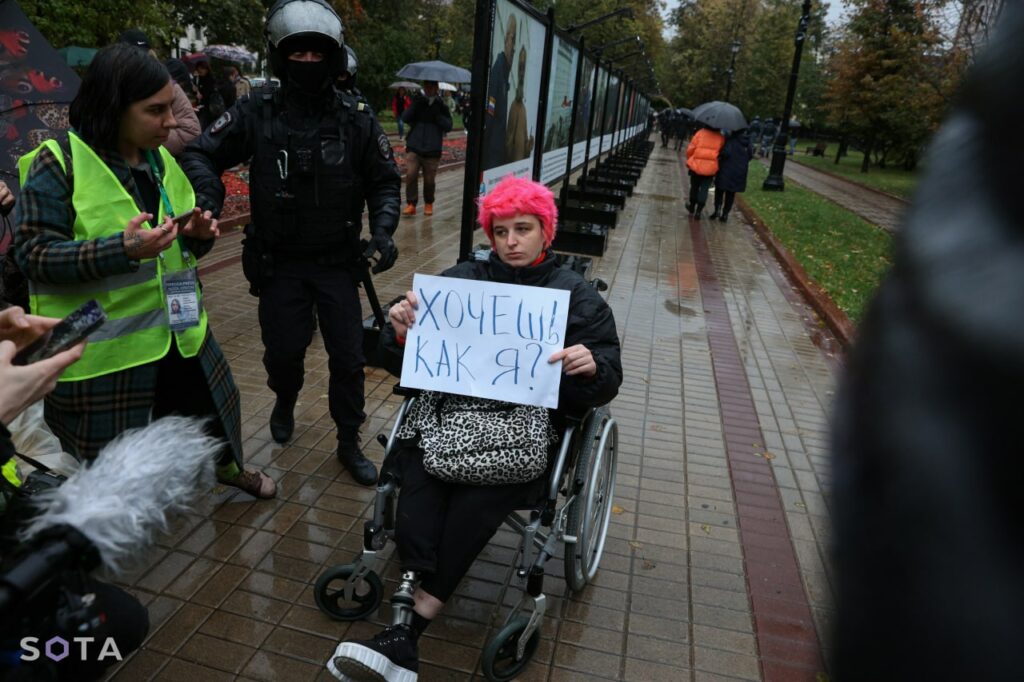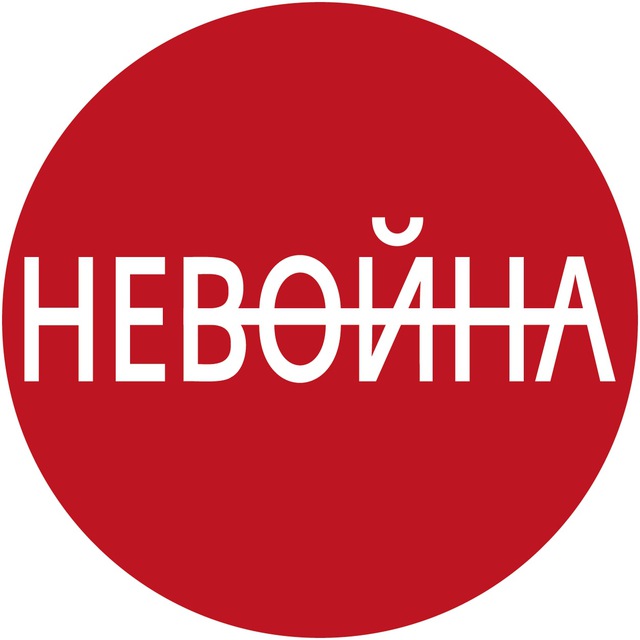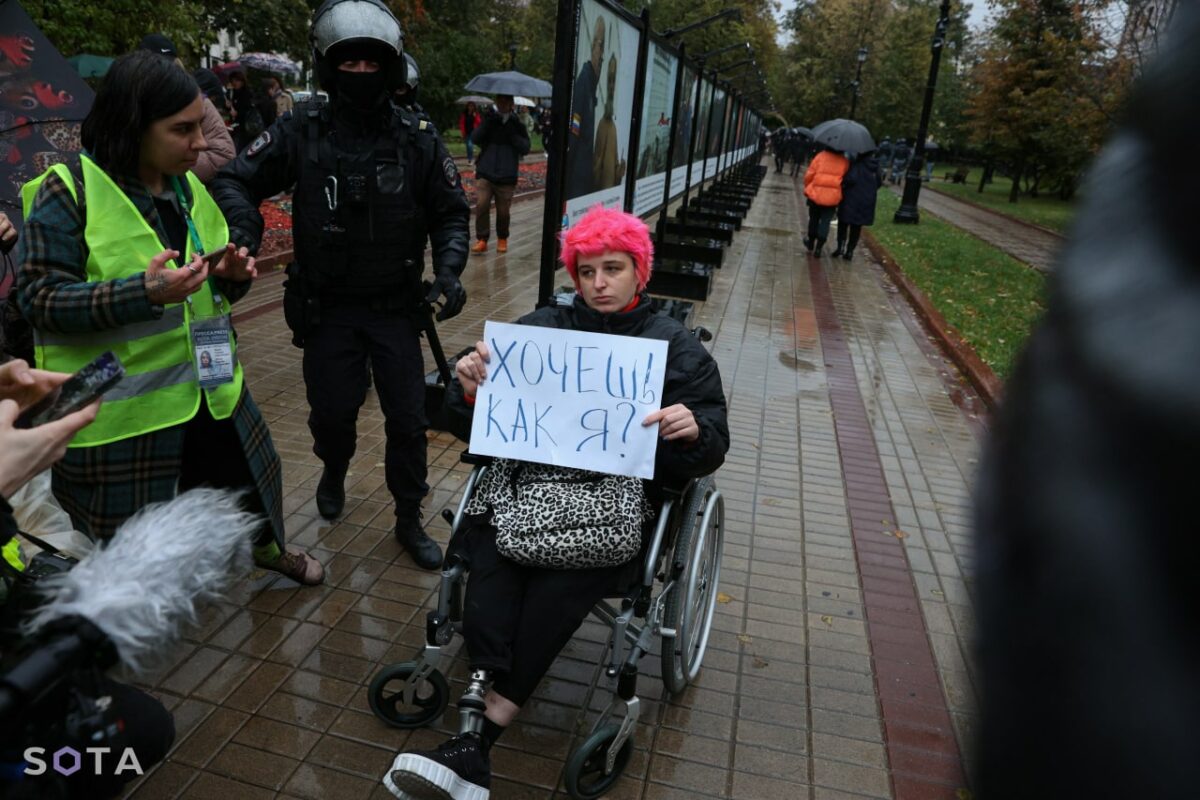On September 21, Putin announced “partial” mobilisation. What does it mean? Who are the most vulnerable to mobilisation? How does it affect civic infrastructures and women’s status? We asked a group of left activists, journalists, and sociologists from Russia, who have been running the anti-war media “Nevoina” (“Notowar”) since the beginning of the full-scale invasion.

LeftEast: On September 21, Putin announced “partial” mobilisation. What does it mean? How “partial” is it?
No one knows this. The authorities traditionally try to hide the unsightly reality from Russians behind rhetorical devices. Minister [of Defence] Shoigu said that the authorities would mobilise “only three hundred thousand people”, i.e. less than one percent of the mobilisation reserve. And pro-government bloggers immediately compared people to jellybeans: they say one jelly bean is very little compared to the whole pack.
Opposition journalists have already published information, citing sources close to the government, that the real mobilisation plans are much greater: 1 million and even 1.2 million people. The second mobilisation wave has already started in some regions. It is virtually impossible to accurately assess the military authorities’ plans. In the general social air, everyone knows a young man between 20 and 50 years old who has received a summons to the military registration and enlistment office (although, this does not always mean guaranteed conscription). What catches the eye behind the discourse about numbers on social networks is the growing number of reports of mobilised men who are forced to live in field camps, sleeping on the ground and digging dugouts because they do not have enough room. This shows that the scale of the mobilisation exceeds the logistical capacity of the military authorities.
LE: Is there any resistance to the mobilisation? Is there any enthusiastic support for it?
According to recent data, about half of those surveyed (51-54%) approve of mobilisation [method of random sampling of telephone numbers (RDD), the sample is stratified by federal districts, Moscow and the Moscow region, St. Petersburg and the Leningrad region (total 10 strata) — LE]. 73% of them are confident that they will not be affected by it.
However, of those most likely to be mobilised (18-29 and 30-39 years old), 78% and 69%, respectively, were not prepared to participate in the “special operation” or had difficulty/refused to answer the question.
There is radical resistance, not very huge, but vivid – every day there is news about the burning down of military recruitment offices. There is public non-violent resistance: solo pickets against mobilisation and the war. We know about collective actions in ethnically non-Russian regions such as Dagestan, in which women are primarily involved. There is “voting with one’s feet”: after the announcement of mobilisation, about a million people left the country. It is a very serious figure, since we are speaking about the core of the young and active population. But the main resistance takes place non-publicly. Many people do not open their doors to police and military registration officers; many do not live where they are registered, including moving to other cities. Recently, there was a curious case when not a single person could be mobilised in an entire village in the North – all the villagers had gone to the forest to pick cranberries. Some regions, such as Altay, have not yet sent a single mobilised person. This is due to successful sabotage and the state’s lack of forces for mobilisation. There is also a version that the sabotage sometimes originates in the local authorities – they anticipate a great redistribution of power and property by force, and want to keep combat-ready people at home, and not send them to die in Ukraine.
Anyhow, the flip side of the notorious dependence on the state, which is thought to be peculiar to the Russians, is the good old skill to sabotage the state if it is particularly active in invading private life. The scale of the country offers good opportunities in this regard.
LE: Can we say that some regions/groups are more vulnerable to mobilisation? Is it based on ethnicity or rather on economic factors? There were discussions about the mobilisation as ethnic cleansing — would you agree with that?
This question is difficult to answer unequivocally, because ethnically non-Russian regions tend to be the poorest and most socially disadvantaged. It is more likely that social factors play a primary role. In the poor and agrarian regions of the country populated by ethnic Russians, mobilisation is also widespread. In many places, the population is ethnically mixed, and recruitment agencies have no means of segregating the ethnic group: conscription is applicable to all.
On the other hand, even before the war some of the pro-regime intellectuals speculated about the ‘new Cossacks’, that is, a military-serving population, the role of which in the Russian empire was given to national minorities. But this doctrine has never been formalised; it has no regulations, no procedures, no bodies and no budget of its own. An important role can be played by the leaders of the national republics, who are wholly dependent on Moscow and Putin personally, and who seek to gain favour with him.
Of course, the smaller a community is, the more it loses from mobilisation. And while ethnic cleansing might be too propagandistic and not particularly accurate a term, some non-Russian ethnic minorities are definitely more powerfully affected by it.
LE: What does the state promise to the mobilised: are they paid, do they get any benefits, can they have their job reserved, do they have to pay their loans, do their families get any support, etc.?
The state promises relatively high, by Russian standards, payments to the mobilised, the same as previously paid to contract servicemen and “volunteers”. More often it’s about 200 thousand roubles, roughly three and a half thousand dollars, a month. This is ten times the salary in economically depressed regions.
In the last fortnight several laws have been passed saying that combatants will receive social benefits and in case of their death their families will be given large sums of money, educational allowances and so on. The authorities are also promising to “reserve” jobs for those who have been mobilised, and the issue of loan waiving is being discussed. Some officials say that the soldiers should repay the loans from their new salaries, while others suggest that the mobilised should have their debts written off. But then the complications begin.
First, as the Russian proverb says, to promise is not to marry. The authorities often deceive people. In the past six months, there have been thousands of cases where contract servicemen have received substantially less money than what they expected. For example, it may depend on the arbitrariness of the unit or unit commander. A great many have encountered difficulties in receiving payments for injuries. Deaths are usually paid for if the death is proven. Data is classified, but apparently thousands of people are listed as “missing”.
Importantly, no more than a third of Russians work on white contracts [formal employment — LE]. The rest are precarious workers in the shadow sector of the economy or even employees of large companies who receive their wages in envelopes (their official wages are 2, 3 or 10 times lower than the real ones). So for most of them the state guarantees of jobs are an empty shell.
The second problem is regional inequality. The bulk of the payments and social benefits for the mobilised soldiers is provided from regional budgets. Their capacities may vary many times. Therefore, soldiers fromMoscow, St. Petersburg or Chechnya––the Russian Federation’s richest regions–are likely to receive considerably more money than ones from Buryatia, Dagestan, Tuva or Krasnodar.
Despite all the promises, there is a massive evasion of the draft in the country. There are hardly any people willing to make money from the war, with the exception of a very few nationalists, whose personnel potential has been exhausted in previous months.
LE: How does mobilisation affect civic infrastructures?
As far as the economy is concerned, mobilisation will not yet turn into a collapse. There will be staff shortages in some sectors. But, firstly, this can be covered by migrant workers. And secondly, there are much more powerful factors undermining the Russian economy.
Sustaining the economy is much harder than sending a million people into the trenches. Russian industry is weak and heavily dependent on imported components. There is no sign that the oligarchic regime is capable of providing the front with weapons and the rear with necessary civilian products. Transport in the Russian regions bordering Ukraine is already congested, but so far there are no signs of a collapse either.
The interesting question is to what extent the military-administrative apparatus will cope with all the necessities of mobilisation. So far, the number of failures is off the charts: the mobilised men lack premises, weapons, uniforms, transport, medicines, nobody trains them and there is no combat cohesion. Prescripts arrive chaotically. They are received by people with disabilities, the elderly, and people with many children. This is probably the result of chaos and overloading in the military apparatus. There are indications that similar problems occur in the justice system and even in the repressive apparatus.
LE: How does it change the position of women? Are women mobilised, too, for example, doctors and medical personnel?
Naturally, as in any war, there is a huge amount of additional work for women to manage the household, look after children, and take care of elderly relatives. There are individual examples of conscripted women being mobilised. But these are rather the exception. The Russian army remains predominantly male. It can be assumed that the labour market is being feminised. This, in the long run, will undermine the conservative gender morality of Putin’s regime. But this is too distant a prospect and is only one of the many factors that influence the situation. According to most sociological surveys, women are more likely to oppose the war than men before the mobilisation. Most anti-mobilisation protests have also been dominated by women, including in Islamic regions such as Chechnya and Dagestan.
LE: What are the other consequences of the mobilisation?
The situation is unprecedented, so it is difficult to make predictions. But the main effect is the “awakening” of the lower social classes. The whole construction of the Putin regime was built on the total alienation of this majority from political reality. Voting for Putin and superficial loyalism were only a form of acceptance of such rules of the game. Whenever the authorities interfered with material reality (e.g. pension reform), this provoked quite massive protests. Mobilisation was a crushing blow to this social contract. Politics invaded the life of the little man in the most brutal and traumatic way. The health and the very lives of hundreds of thousands of people are at stake. And this undermines the credibility and validity of the whole ideological foundation of the Putin regime, built on promises of stability, security and peace.
LE: Among anti-war activists, is there any discussion about whether draft-eligible people should be leaving the country or resisting the draft?
Those who leave are both the most vulnerable to conscription and in possession of the resources needed to go abroad. For those who stay, the main task is not only to avoid going to the front but also to prison, from which it will not be so easy to get out, even when the regime starts to collapse. Those who leave, since they are secure, should try to reach through media as many people living in Russia as possible, and be prepared to return as soon as the possibility to influence events from within proves greater than the risk of being repressed.
LE: Is there any hope now? What do you think the left can do in Russia now?
It is precisely at this moment that there is hope. It’s obvious that the Russian regime has stepped into the trap, that Russia is becoming a weak link in global capitalism, as it was 100 years ago. It’s obvious that the left and the democratic forces have a chance to finish with the neoliberal project in Russia and thereby influence global processes. And it doesn’t really matter whether the probability of such an optimistic outcome is 5% or 50%. It only matters that this chance exists and we have to do everything we can to take it.
What can the left do in Russia? Maintain themselves and their social ties. For those who aren’t ready to get involved with the underground anti-war activity, if possible, get involved with public affairs that aren’t directly connected to the war. This could be volunteer work, like support for refugees. This could be environmental activism, workers’ rights, human rights, support for political prisoners. A huge problem is that since the start of the war it has become more difficult for social activists to act, not only because of increased repression but also because of the difference of opinion between them. It’s worth showing that people who don’t support the militarist craze are still fighting for the interests of 99% of Russians – ecology, human rights, labour rights… Whatever may divide us today, however many of our compatriots may be misguided today, tomorrow we may find ourselves in the same camp. Everyone except Putin’s officials, the war criminals, and the propagandists. And the task of the left is to ensure that this camp would be united by our values and our programme: social equality, political freedoms, democracy at all levels of society – from factory to parliament, local self-government, internationalism.

“Nevoina” (“No(to)war”) is convinced that if the leadership of our country started the war, then society must stop it. To do this, it is necessary to understand the historical causes of the war; see its political, economic, and cultural background; analyse its dynamics. This will allow us to understand how we want to see Russia and the world after the end of the war.
“Nevoina” is being run by a team of like-minded people: left-wing politicians, activists, journalists, and sociologists. We try to reflect daily on the causes, contexts, and consequences of the war together with our subscribers. We believe that society is the main actor in history. Therefore, we give voice to its diverse representatives, analyse public sentiments, and support social movements, collective initiatives, and activists.

